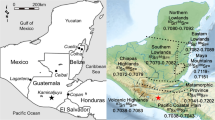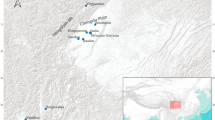Abstract
The oxygen and carbon isotopic ratios in human and animal tooth enamel were measured to reconstruct the subsistence patterns on Zhongba Site between 2400 and 4200 aBP. The results indicate that human consumed chiefly C4 resources, such as millet, and the C3 plants, such as rice and wheat, constituted only a small fraction of the human diets, normally no more than 15%. There are significant differences in food sources between human and pig, and the percentages of C3 plants in pig diets were higher than those in human diets. But the δ 13C values of pig partially overlap those of human, demonstrating some similarities in their food sources. The differences in water sources between human and pig are significant. There are significant differences in food and water sources between cattle and deer. This indicates that the two kinds of mammals subsisted in different niches. But their δ 13C values also partially overlap each other, suggesting some similarities in their food sources. There are both significant differences in mean δ 13C and δ 18O values between the omnivores, human and pig and the herbivores, cattle and deer, implying significant differences in food and water sources between the two categories. During the period the dietary habits of human had not changed, but the pig breeding strategies had changed, from breeding in house to breeding in confinement, and the proportion of C3 plants in pig food increased with time. The scope of human migration had been considerably large by the Warring States because of the development of productive forces.
Similar content being viewed by others
References
Bryant J D, Froelich P N. A model of oxygen isotope fractionation in body water of large mammals. Geochim Cosmochim Acta, 1995, 59: 4523–4537
Schoeninger M J, Reeser H, Hallin K. Paleoenvironment of Australopithecus anamensis at Allia Bay, East Turkana, Kenya: evidence from mammalian herbivore enamel stable isotopes. J Anthropol Archaeol, 2003, 22: 200–207
Schoeninger M J, Hallin K, Reeser H, et al. Isotopic alteration of mammalian tooth enamel.International. J Osteoarchaeol, 2003, 13: 11–19
Newesely H. Fossil bone apatite. Appl Geochem, 1989, 4: 233–245
Ayliffe L K, Chivas A R, Leakey M G. The retention of primary oxygen isotope composition of fossil elephant skeletal phosphate. Geochim Cosmochim Acta, 1994, 58: 5291–5298
Antoine Z, Christophe L, Simon M F. Diagenesis and the reconstruction of paleoenvironments: A method to restore original δ 18O values of carbonate and phosphate from fossil tooth enamel. Geochim Cosmochim Acta, 2004, 68: 2245–2258
Hoppe K A. Isotopic variability, herd structure, and migration patterns of Late Pleistocene mammoths from multiple death assemblages. Paleobiology, 2004, 30: 129–145
Lee-Thorp J A, Merwe N J. Carbon isotope analysis of fossil bone apatite. South African J Sci, 1987, 83: 712–715
Merwe N J, Medina E. Photosynthesis and 13C/12C ratios in Amazon rain forests. Geochim Cosmochim Acta, 1989, 53: 1091–1094
Wright L E, Schwarcz H P. Stable carbon and oxygen isotopes in human tooth enamel: identifying breastfeeding and weaning in prehistory. Am J Phys Anthropol, 1998, 106: 1–18
Luz B, Kolodny Y. Oxygen isotope variations in phosphate of biogenic apatites: IV. Mammal teeth and bones. Earth Planet Sci Lett, 1985, 75: 29–36
Zhu C, Zheng C G, Ma C M, et al. Identifying paleoflood deposits archived in Zhongba Site, the Three Gorges reservoir region of the Yangtze River, China. Chin Sci Bull, 2005, 50(21): 2493–2504
Yi Sangheon, Yoshiki S, ZHAO Quanhong et al. Vegetation andclimate changes in the Changjiang (Yangzi River) Delta, China, during the past 13000 years inferred from pollen records. Quat Sci Rev, 2003, 22: 1501–1519
Flad R K. Specialized Salt Production and Changing Social Structure at the Prehistoric Site of Zhongba in the Eastern Sichuan Basin, China. Dissertation for the Doctoral Degree. Los Angeles: University of California, 2004. 235–270
Wang Y, Cerling T E, MacFadden B J. Fossil horses and carbon isotopes: new evidence for Cenozoic dietary, habitat, and ecosystem changes in North America. Paleogeogr, Paleoclimatol, Paleoecol, 1994, 107: 269–279
Paul L K, Kathryn A H, David W. The isotopic ecology of late Pleistocene mammals in North America. Part 1. Florida. Chem Geol, 1998, 152: 119–138
Cerling T E, Harris J M, Ambrose S H, et al. Dietary and environmental reconstruction with stable isotope analyses of herbivore tooth enamel from the Miocene locality of Fort Ternan, Kenya J Human Evol, 1997, 33: 635–650
Merwe N J, Thackeray J F, Lee-Thorp J A, et al. The carbon isotope ecology and diet of Australopithecus africanus at Sterkfontein, South Africa. J Human Evol, 2003, 44: 581–597
Bryant J D, Koch P L, Froelich P N, et al. Oxygen isotope partitioning between phosphate and carbonate in mammalian apatite. Geochim Cosmochim Acta, 1996, 60: 5145–5148
Krigbaum J. Neolithic subsistence patterns in northern Borneo reconstructed with stable carbon isotopes of enamel, J Anthropol Archaeol, 2003, 22: 292–304
Sponheimer M, Lee-Thorp J A. Oxygen Isotopes in Enamel Carbonate and their Ecological Significance J Archaeol Sci, 1999, 26: 723–728
Iacumin P, Nikolaev V, Genoni L, et al. Stable isotope analyses of mammal skeletal remains of Holocene age from European Russia: A way to trace dietary and environmental changes. Geobios, 2004, 37: 37–47
White C D, Pohl E D, Schwarcz H P, et al. Isotopic Evidence for Maya Patterns of Deer and Dog Use at Preclassic Colha. J Archaeol Sci, 2001, 28: 89–107
Pechenkina E A, Ambrose S H, Ma X L, et al. Reconstructing northern Chinese Neolithic subsistence practices by isotopic analysis. J Archaeol Sci, 2005, 32: 1176–1189
Abdulla A. Stable carbon isotope analysis of human tooth enamel from the Bronze Age cemetery of Ya’amoun in Northern Jordan. J Archaeol Sci, 2004, 31: 1693–1698
Hu Y, He D, Dong Y, et al. Stable carbon isotope analysis of human bones from the Xigongqiao Site, Tengzhou, Shangdong. Quat Sci, 2005, 25(5): 561–567
Masao M, Akira M, Naotaka I. Patterns of prehistoric boar Sus scrofa domestication,and inter-islands pig trading across the East China Sea,as determined by carbon and nitrogen isotope analysis. Chem Geol, 2005. 218: 91–102
Author information
Authors and Affiliations
Corresponding author
Additional information
Supported by the Key Project of the National Natural Science Foundation of China (Grant No. 90411015), the University Doctoral Foundation (Grant No. 20050284011), the Foundation of Important Basic Research at Nanjing University (Grant No. 0209005206), the Open Foundation of the State Key Laboratory of Loess and Quaternary Geology from the Institute of Earth Environment, CAS (Grant No. SKLLQG0503), the Physical Geography of “985” Items and the Test Foundation of Modern Analyses Center of Nanjing University (Grant No. 0209001309)
About this article
Cite this article
Tian, X., Zhu, C., Xu, X. et al. Reconstructing past subsistence patterns on Zhongba Site using stable carbon and oxygen isotopes of fossil tooth enamel. Chin. Sci. Bull. 53 (Suppl 1), 87–94 (2008). https://doi.org/10.1007/s11434-008-5001-z
Received:
Accepted:
Published:
Issue Date:
DOI: https://doi.org/10.1007/s11434-008-5001-z




